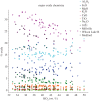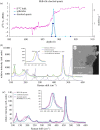The extraterrestrial impact evidence at the Palaeocene-Eocene boundary and sequence of environmental change on the continental shelf
- PMID: 30177564
- PMCID: PMC6127391
- DOI: 10.1098/rsta.2017.0081
The extraterrestrial impact evidence at the Palaeocene-Eocene boundary and sequence of environmental change on the continental shelf
Abstract
We have identified clear evidence of an extraterrestrial impact within the onset of the carbon isotope excursion (CIE) that defines the Palaeocene-Eocene (P-E) boundary hyperthermal event (approx. 56 Ma) from several sites on the eastern Atlantic Coastal Plain and offshore. We review and update the state of the evidence for an impact at the P-E boundary, including a K-Ar cooling age of the ejecta that is indistinguishable from the depositional age at the P-E, which establishes the ejecta horizon as an isochronous stratigraphic indicator at the P-E. Immediately above the ejecta peak at the base of the coastal plain Marlboro Clay unit, we identify a sharp increase in charcoal abundance coincident with the previously observed dramatic increase in magnetic nanoparticles of soil pyrogenic origin. We therefore revisit the observed sequence of events through the P-E boundary on the western Atlantic Coastal Plain, showing that an extraterrestrial impact led to wildfires, landscape denudation and deposition of the thick Marlboro Clay, whose base coincides with the spherule horizon and CIE onset. The Sr/Ca ratio of the spherules indicates that the carbon responsible for the onset may be vaporized CaCO3 target rock mixed with isotopically light carbon from the impactor or elsewhere. Crucially, we do not argue that the impact was responsible for the full manifestation of the CIE observed globally (onset to recovery approx. 170 kyr), rather that a rapid onset was triggered by the impact and followed by additional carbon from other processes such as the eruption of the North Atlantic Igneous Province. Such a scenario agrees well with recent modelling work, though it should be revisited more explicitly.This article is part of a discussion meeting issue 'Hyperthermals: rapid and extreme global warming in our geological past'.
Keywords: Palaeocene–Eocene Thermal Maximum; carbon cycle; extraterrestrial impact; hyperthermal; impact ejecta.
© 2018 The Author(s).
Conflict of interest statement
The authors declare that they have no competing interests.
Figures









References
-
- Gradstein FM, Ogg JG. 2012. Chapter 2—The chronostratigraphic scale. In The geologic time scale (eds FM Gradstein, JG Ogg, M Schmitz, G Ogg), pp. 31–42. Boston, MA: Elsevier.
-
- Aubry M-P, Ouda K, Dupuis C, Berggren WA, Couvering JA. 2007. The Global Standard Stratotype-section and Point (GSSP) for the base of the Eocene Series in the Dababiya section (Egypt). Episodes 30, 271–286.
-
- Kennett JP, Stott LD. 1991. Abrupt deep-sea warming, palaeoceanographic changes and benthic extinctions at the end of the Palaeocene. Nature 353, 225–229. (10.1038/353225a0) - DOI
-
- Koch PL, Zachos JC, Gingerich PD. 1992. Correlation between isotope records in marine and continental carbon reservoirs near the Palaeocene/Eocene boundary. Nature 358, 319–322. (10.1038/358319a0) - DOI
-
- Kahn A, Aubry M-P. 2004. Provincialism associated with the Paleocene/Eocene thermal maximum: temporal constraint. Mar. Micropaleontol. 52, 117–131. (10.1016/j.marmicro.2004.04.003) - DOI
Publication types
LinkOut - more resources
Full Text Sources
Other Literature Sources
Research Materials
Miscellaneous

